Collecting Robert Maxwell
by Jack Chipman
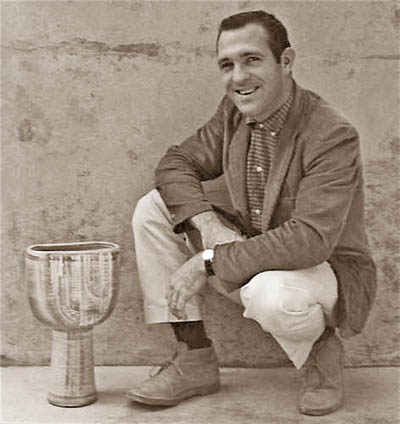
Robert Maxwell in 1959 at the time he received his Masters
degree from UCLA.
|
|
The collecting of Robert Maxwell ceramics is an activity gaining momentum. Many people fervently hunt for his signature animals while others are passionate about his distinctive handmade pots. Because he was arguably the most prolific and versatile potter of his era, an ample and wide range of objects are still out there to be found.
|
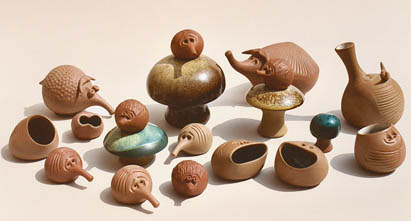
I believe this abundance may be keeping Maxwell's prices from rising to a higher level. The fact that he was in mass-production for over seven years has added to the availability. As the supply dwindles his values will surely rise--especially for the handcrafted pieces. Although handmade animals and other stoneware items were made from the beginning, they were far fewer in number than the slip-cast articles. The molded work will always have its appeal, but collectors who single out pieces made by hand may be the savviest.
|
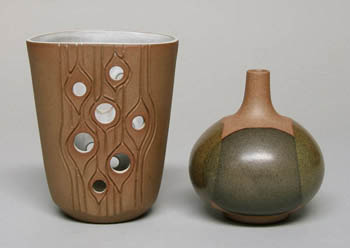
Limited supply is bound to add to the value of the early slip-cast animals produced at the Winfield China plant in Santa Monica. These can be recognized by their white porcelain body (check the underside cavity) with a thin pebbly coating sprayed on to simulate the natural look of stoneware. This assisted production lasted only about 6 months so a very limited supply is out there and we know all about supply and demand.
|
|
In 1964, after the U Name It book was published, a contract was obtained from the Ohio Art Co of Bryan, OH for production of vinyl toys called Stickie Ickies. They were based on Maxwell's unique critters, but due to manufacturing problems no more than 5,000 were produced. Three different models (in assorted colors) were made. They all had suction cups as bases and operated like squirt guns for bath-time fun. Any of them would be are hard to find in good condition.
|
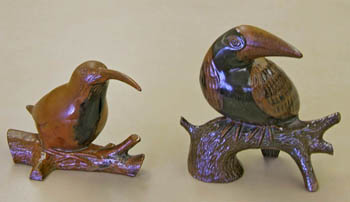
Click on image to see additional pictures
Also hard to find is the series of clearly identifiable zoo animals and birds that came out near the end of the Venice production. Some of the slip-cast birds were mounted on wood bases and oftentimes were glazed. The zoo animals were usually unglazed and tended to be humorous in appearance.
|
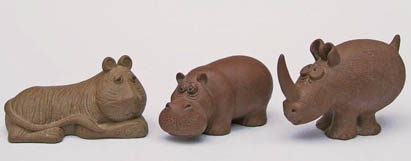
The hunt for Maxwell's handmade ceramics will ultimately locate more unglazed items with carved texture and/or designs than items with added glaze. The potter has made it clear that glazing is not his favorite part of the process so much of his work will be found in the unglazed state. His appreciation for the texture and natural color of stoneware, which can be manipulated during firing to produce many different hues, may be the main reason for the paucity of glaze. The basic stoneware palette covers a wide range from light tan to rust.
|
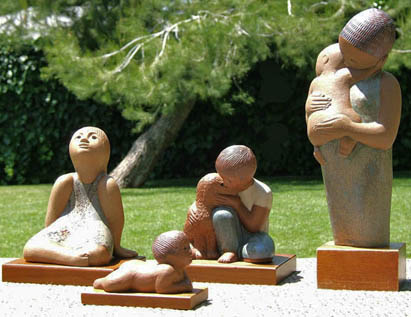 Click on image to see additional pictures
Click on image to see additional pictures
Rounding out the Maxwell production phase were two charming series of figures that independent designers Noel Osheroff and Arlene Lopez sculpted for the line. Robert met Noel Osheroff through his association with David Cressey. The Osheroff designed figures depicted individuals in familial poses; mother with child, father with son, boy with dog, baby, etc--in a range of muted satin-matte glazes and were usually mounted on a wood base. Arlene Lopez was a actually a former student of Robert's. The Lopez designed figures are small (2.5 to 3 inches tall) and unglazed. There were 12 humerous figures depicting a variety of humans such as a bride and a groom, surfer, golfer, skier, bullfighter, woman with crying baby, cowboy and others. A number of these figures have rather "grumpy" expressions. Both the Osheroff and Lopez figures had limited production runs.
|
|
Maker's Marks
|

|
Early hand-incised mark on handmade animal, circa 1959.
|
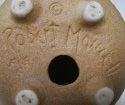
|
In-mold mark on early animal produced at the Winfield China plant in Santa Monica with white clay body and faux stoneware texture.
|

|
Typical in-mold mark on vintage slip-cast animal.
|
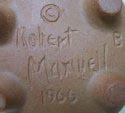
|
In-mold mark on vintage animal that includes date and copyright symbol.
|

|
Closeup view of dated in-mold mark commonly found on slip-cast animals.
|

|
In-mold mark on vintage slip-cast low bowl.
|

|
Hand-incised mark on vintage handthrown platter.
|
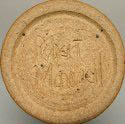
|
Typical hand-incised mark on a vintage handthrown vase.
|
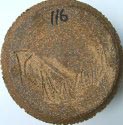
|
Vintage handmade items were sometimes incised R Maxwell.
|

|
Maxwell's jungle animals were usually impressed with this mark, plus a paper label was usually added.
|

|
Large paper labels were affixed to many vintage slip-cast items and sometimes were the only marking.
|

|
This smaller paper label was affixed to smaller vintage slip-cast items.
|
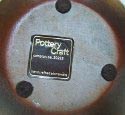
|
Pottery Craft paper label. Robert Maxwell did not design any Pottery Craft items.
|

|
Hand-incised Earthgender mark on handthrown pot. Earthgender Inc. was a partnership between Maxwell and David Cressey.
|

|
A recent handmade animal with a hand-incised mark that incluses a non-abbreviated date.
|
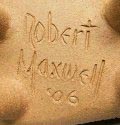
|
Hand-incised mark on recent handmade animal that includes an abbreviated date.
|

|
Hand-incised mark on recent handmade animals.
|
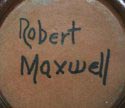
|
A previously unmarked item recently hand-signed with a Sharpie marker.
|
|
|
The similarity between Robert Maxwell's output and Treasure Craft's "Pottery Craft" division can be confusing to collectors. The ill-fated merger of Maxwell's business with Treasure Craft lasted only about six months. This unfortunate episode marked the end of slip-cast production for Maxwell because his master molds were in the possession of Treasure Craft and could not be retrieved. A lawsuit against Al Levin's business was settled out of court, but that didn't stop Levin from producing Pottery Craft--a line that closely mimicked the Maxwell slip-cast production. Although the Maxwell molds were never used, new shapes employing his clay formula and glazes as well as his distinctive method of pouring the glaze to form overlapping patterns were produced in abundance. Adding to the confusion is the fact that Maxwell and Pottery Craft items were routinely marked only with paper labels.
|
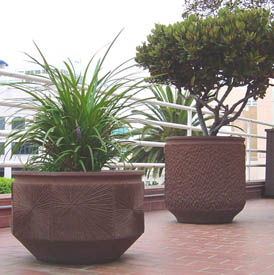
|
The massive Earthgender planters of the 70s already command a high price. These containers are in the same league as the mid-century modern planters designed by David Cressey and others for Architectural Pottery of Manhattan Beach. I predict that prices will rise even more as they attain greater recognition and acceptance. They weren't always marked so bargains can still be had despite a limited supply if you know what to look for.
Click on image to see additional pots
|
|
|
Speaking of marks, one thing that distinguishes Robert Maxwell's individual output is the clarity of his signature. No doubts about attribution arise when one of his pots is found. Some pieces were signed (incised) simply "R Maxwell" but most include an easy-to-read full printed signature. The same cannot be said for most studio pottery that turns up on the secondary market. On the other hand, Maxwell pieces of the 60s and 70s are difficult to place in time since none were dated. Fortunately, the majority of pottery created during the Ramona Convent period contains the year as part of the signature. For a comprehensive listing of Maxwell markings and paper labels, see Maker's Marks at the upper right-hand side of this page.
|
|
|